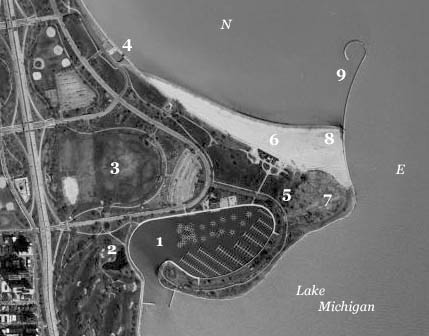To most birders in Chicago, Montrose is a must for any day in spring migration. It is one of the first land masses birds see when they come to shore after a day of migration, and has fantastic habitat for all types of migrants. When one arrives at Montrose early in the morning, the beach is usually the first spot to check. This area is located to the left of the fishhook pier and will usually have a variety of water birds. In migration, one can find Ruddy Turnstone, Greater and Lesser Yellowlegs, Least and Semipalmated Sandpipers, Sanderling, Semipalmated Plover, Whimbrel, Willet, and sometimes even the rare Marbled Godwit. There can be Common and Forester’s Terns on the beach with the gulls, and sometimes uncommon gulls mixed in.
Moving into the native grasslands, one can encounter a variety of new species. Nelson’s and LeConte’s Sparrows are usually the high point for some in fall migration, as they are uncommon migrants and with a bit of searching can be found in the grasses. Short-eared Owls are known to be in the grasses and can be found with luck. One can also find Horned Lark, Lapland Longspur, and other sparrow species. Harris’s Sparrows sometimes can be found in the willows that are throughout the grasses, but they are usually only found once or twice in migration.
In the actual sanctuary, there is a vast system of trails that birders like to walk daily to find all the birds present. The Magic Hedge is located in the north part of the sanctuary and is known as on of the best spots in migration for warblers and other birds at Montrose. In one day, there can be over 20 species of warbler, including less common species like Mourning Warbler, Connecticut Warbler, Black-throated Blue Warbler, Golden and Blue-winged Warbler, and more. There is also a water drip for birds to drink from, which can also hold good migrants since there is a dead tree next to it for birds to perch in. If you come to Montrose in early May, it is almost a guarantee you will run into other local birders at the Magic Hedge, as well as throughout the Sanctuary.
Montrose is also an amazing magnet for uncommon to rare birds. Bob Hughes has recorded over 330 species at Montrose, and recent uncommon birds have been Burrowing Owl, Western Grebe, Black-legged Kittiwake. Many first state records have been found at Montrose, and that is most likely due to the numbers of birders that travel there. Bob Hughes has a website dedicated to Montrose birding, which can be viewed at here: http://theorniphile.info/montrose_primer.html
1) Montrose Harbor
2) Golf Course Pond
3) Cricket Hill
4) Wilson Boat Launch
5) The Magic Hedge
6) Montrose Beach
7) The Meadow
8) Montrose Dunes
9) Fishhook Pier
(Courtesy of Bob Hughes and the Montrose Primer (http://theorniphile.info/montrose_primer.html)
